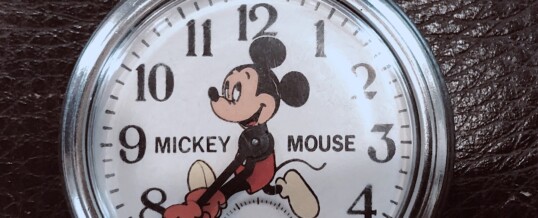
As we left Ashdown, Arkansas, in my mom’s 1971 Buick Electra 225 Limited, my mom turned to my dad and asked, “Jimmy, are you sure we have enough money?”
He responded, “Well, Mary. If four hundred dollars isn’t enough to spend two weeks at Disney World, then we might as well stay home.”
It was 1973. That four hundred was to cover gas, hotels, meals, tickets to a relatively new Disney World, souvenirs, and incidentals. And it did. With some left over.
My wife and I just got back from a trip to Alaska. We spent almost four hundred to park our car at the airport.
Times and costs have changed a lot.
There’s a TV show called Larry’s Country Diner. They don’t make the show anymore, but I still watch the reruns.
Larry is a former disc jockey. Being one of those myself, I can relate to the guy.
One of the ways you get and keep listeners on a radio show is to have what are called “benchmarks.” Simply put, a benchmark is an interesting bit you do on-the-air at the same time every day.
It gives the listener something to look forward to, and with it occurring at the same time every day, it also tells them what time it is so that they know whether or not they’re on schedule.
Larry recycled an old radio bit at the beginning of each of his TV shows. It’s called, “On this date in history.”
Most DJs did the bit, but they talked specifically about events. Larry spun that by talking about what things cost. That reminded me of vacations past and present.
The Alaska trip brought to light just exactly how much everything has gone up in price.
My dad was born in 1938. So let’s compare.
According to BusinessInsider.com, the average income that year was $1,731. Granted, that assumes that in the middle of the Great Depression you had a job.
Other jaw-dropping amounts include a gallon of milk being fifty cents, a gallon of gas a dime, a movie ticket was twenty-five cents, rent averaged $27 a month, a postage stamp was three cents, a house went for $3,900, and you could send your kid to Harvard for $420 a year.
To clarify, no one in my family ever went to Harvard.
Disney World in 1973 wasn’t that cheap, but it still seems inexpensive compared to now.
In 1973, an adult ticket to Florida’s Magic Kingdom was $4.50. A kid’s ticket was $1.50.
That $400 suddenly seems plausible.
The Red Carpet Inn where we stayed in Kissimmee, Florida, was about $12 a night. We could’ve stayed at a budget hotel down the street for $6 to $10 a night. But the Red Carpet Inn had a Laundromat, which was a deal breaker for my mom.
In 1973 at McDonald’s, my dad paid twenty-eight cents for each of our hamburgers, and twenty-six cents for french fries. We didn’t eat much at Disney World, because burgers there cost more than a dollar.
My aunt, uncle and two of my cousins also went with us, so some of the costs, such as gasoline, were shared.
Each kid was allowed to pick one souvenir from the Disney World gift shop. I selected a wind-up Mickey Mouse watch. It cost around $8. It’s still around somewhere.
On our trip to Alaska, my wife and I took a cruise. Much of the outing was spent on board the ship and was all-inclusive, but suffice it to say, if we’d spent that same money in 1938, we could have bought each of our kids a house.
The excursions off ship (whale watching, riding the Yukon Railroad, looking at glaciers) were each akin to a 1973 week at Disney World.
Of course, I had to pick up the obligatory souvenirs for family back home. A jigsaw puzzle of a glacier for mom, Alaska ball caps for the men, T-shirts, etc. The cost of which would have fed us at a 1973 McDonald’s. For a year.
I know I sound like my grandparents when it comes to what everything cost, but I can’t help it. Because back in my day, we could go to Disney in Florida for a week for just $400.
And if we couldn’t, we just stayed home.
©2024 John Moore
John’s books, Puns for Groan People and Write of Passage: A Southerner’s View of Then and Now Vol. 1 and Vol. 2, are available on his website TheCountryWriter.com, where you can also send him a message.
SEP
2024
